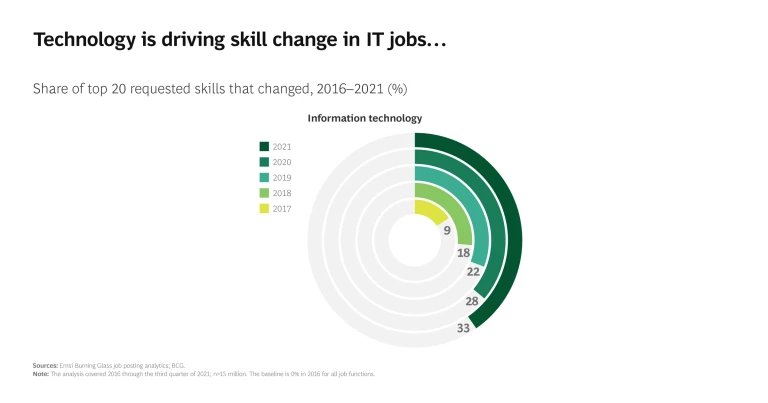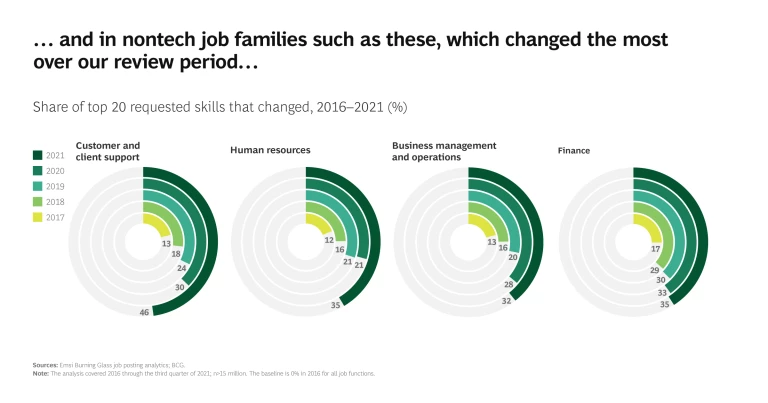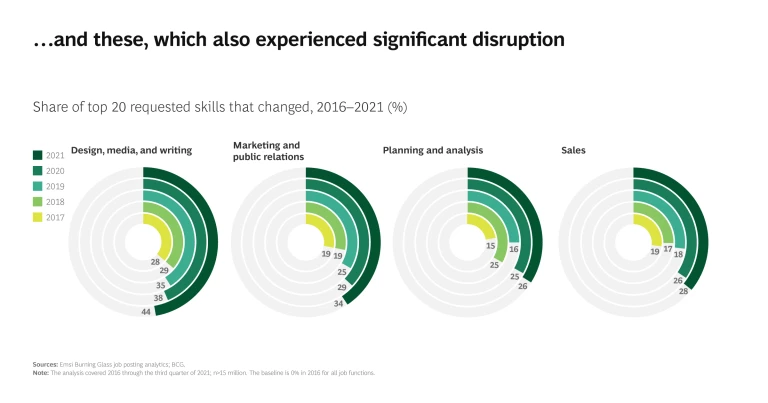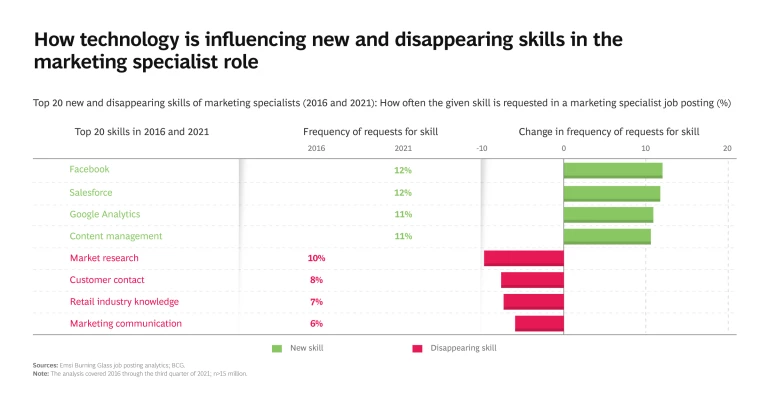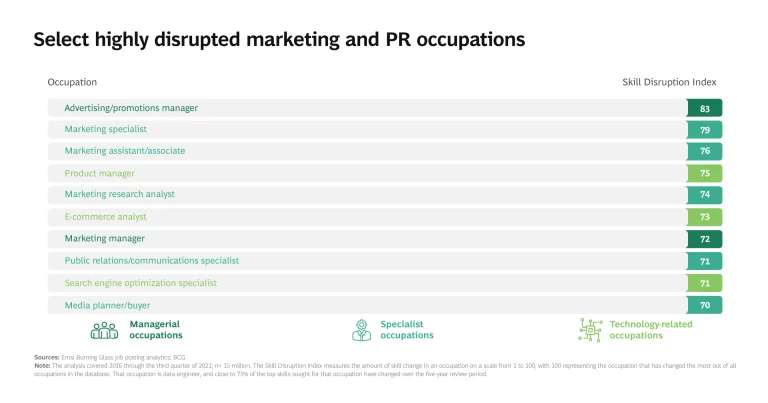Discussions about the job market usually focus on jobs created and destroyed. But even in the most tumultuous times, that is not what most workers or most businesses experience. Jobs do come and go, but even more significantly, jobs change. Day by day, skill by skill, the basic building blocks of a job are repositioned, until the role looks much different than it did just five years ago. Yet the job title—and the worker in the job—may remain the same.
But even company leaders may not realize how profoundly and rapidly the jobs throughout their business and industry are evolving. A comprehensive look at job listings from 2016 through 2021 reveals significant changes in requested skills, with new skills appearing, some existing skills disappearing, and other existing skills shifting in importance.
The challenge for employers and employees alike is to keep up—or, better yet, to get ahead of the trends.
The Skill Disruption Index
To meet the challenge , we analyzed millions of online job advertisements posted between 2016 and 2021 and created the Skill Disruption Index, which yielded a comprehensive list of occupations, each assigned a relative value from 100 for the job with the greatest disruption (data engineer) to 0 for the job with the least disruption (mystery shopper).
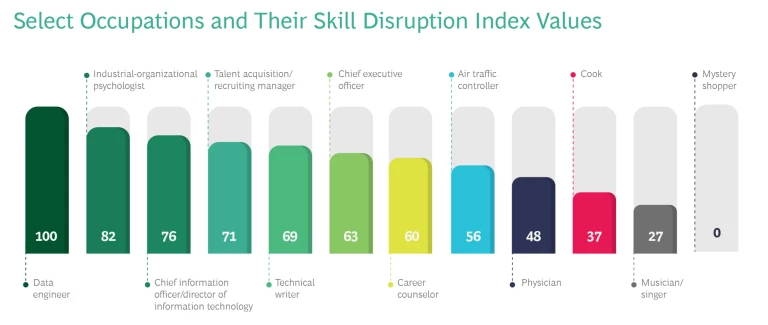
We looked at the skills that employers requested in job postings each year and compared those skills with the ones requested for the same occupation in 2016. We broke down the change in two ways. First, we looked at the skills that were completely new to jobs—the ones that employers didn’t ask for at all in 2016. Then, we looked at whether skills became more or less important to a role. Were they requested more or less frequently as time went on? The first way of breaking down skills is like seeing the initial blip on a radar screen; the second is more akin to using the Doppler effect to see if the target is speeding up or slowing down.
The Skill Disruption Index, which combines the two measures mentioned above (the emergence of new skills and the change in the importance of skills), allows us to compare how rapid and significant the changes are in specific roles. (The full report includes an appendix showing how all occupations in the database rank in the Index.)
In fact, the pace of change has accelerated such that jobs are more disrupted today than ever before: we consider this period of time to be the Great Disruption, a workforce phenomenon that demands swift and thoughtful action by employers and other stakeholders. Leaders and decision makers need to understand what skills their organization needs and how to access them. Essentially, they need to capture a moving target.
What’s Driving Skill Disruption?
In reviewing the five-year data, we detected an acceleration in the pace of change. Nearly three-quarters of jobs changed more from 2019 through 2021 (a CAGR of 22%) than they did from 2016 through 2018 (19%).
We attribute this increase to the pandemic, which forced businesses to rethink operations and people in all kinds of occupations to embrace new ways of working and new skills.
But the main driver of change in requested skills is technology. Technology is reshaping many, if not most, jobs. Sometimes this is dramatic, as in the explosion of phone apps in e-commerce. Sometimes, it is subtle: the replacement of the clipboard by the tablet in fields from trucking to health care or the price gun by the barcode in the supermarket.
The impact of technology change extends far beyond fields that are intrinsically technical, like IT, engineering, and science and research. The proliferation of technologies that can be put to effective use in these roles is changing the understanding of “tech job.” A marketing specialist, a client support employee, a writer, an HR manager—and many more—must now have technical proficiencies as well as their traditional expertise. See the slideshow below.
What Skill Disruption Looks Like
A closer look at skill disruption in one job family—marketing and public relations—shows the impact of skill disruption. The marketing and PR job family is a useful example: companies across industries include this department, so it’s widely relevant.
Drilling down further into one specific occupation—marketing specialist—is a good proxy for skill disruption in this job family overall as well as the way technology is driving skill change. “Marketing specialist” is a common role (15% of postings for marketing jobs are for marketing specialists) that exists in multiple companies and industries, and requested skills changed significantly over the past five years. Thus, a deeper look at the skills requested of a marketing specialist approximates the skill changes across the entirety of the job family. See the slideshow below.
Four Big Trends
We see four big trends in skill change:
- Digital skills, like technical fluency and abilities including data analysis, digital marketing, and networking, aren’t limited to jobs in IT.
- Soft skills, like verbal communication, listening, and relationship building, are needed in digital occupations.
- Visual communication has become increasingly important even outside of traditional data occupations. Experience with tools such as Tableau, MS Power BI, and Adobe Analytics is in high demand.
- Social media skills, such as experience with Facebook, LinkedIn, and Adobe Photoshop, are in demand in the current media climate.
Implications for Stakeholders
Over just five years, skill change has been rapid and wide ranging. In some occupations, it has been overwhelming. The consequent impact on organization leaders, HR teams, educators, public-sector agents, and individuals is profound. There’s a need to seek talent with new skills, to reskill and upskill employees, and to train and develop those in search of jobs. And all of this must happen while the skill profiles of many jobs continue to morph—it’s a moving target.
The good news is that with the help of big data and analytics—tools that underpin this very report—we can understand the nature and details of the changes.





